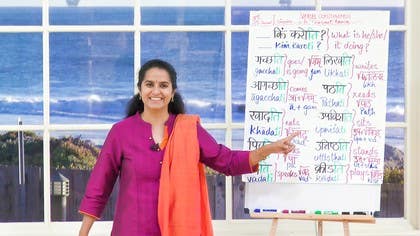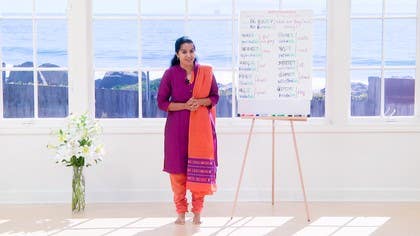Description
About This Video
Transcript
Read Full Transcript
Namaste, dear friends. We've been on this big journey of discovering the different forms of the pronouns. We've also had a look at now the verbs and to see how the verb gives us many codes. By looking at the form of a verb, we know who is doing it, we know how many of them are doing it and we know when they are doing it. So what we've focused on thus far that we had Alana with us demonstrate was the third person singular. And if you remember, we had the word ending with T. The T was characteristic of the third person singular in the present tense. So just looking at it here, the question for what is she doing or what is he doing? What is it doing? Or even you formal, what are you doing? For us fortunately, they all take the same verb conjugation and that is gachati, gachati. So kinkaroti, what is he, she, it, you, formal doing? The answer is gachati which is goes. The same as is going, the present continuous. So gachati, call that gachati. This is we've already heard the word seen the action. Now we'll just connect it to the writing of that particular word, gachati, call it. The root of T, of gachati is gum, gum. And in the transliteration, it's gum. The next verb that we saw was aagachati, the same pattern T at the end. So aagachati which is comes and that's what it looks like, aagachach, the short ch and the aspirated chati, aagachati comes. The root is the same, gachati but it has the prefix a which tells you the direction of that action. So a plus the root gum. Some of you might be wondering how the gum becomes gachati. Now the root gum turning into gachati is the hardware question and that's not something that we are going to look at really at this stage. It has its own set of rules which are very specific. But for us what we really need and what you are going to find in your literature is that the root gum to go becomes gachati. You'll see various forms of that word. So gachati goes, aagachati comes, kadati, kadati is eat and this is what it looks like, kadati eats or is eating. I have just written it once here but you know it works for all of them there. The root of kadati is khad. I'll also put it here once in the transliteration for the aagachati. So a plus gum and for khad it is khad. Now peebati drinks looks like that peebati. In transliteration the root of peebati is again a little different. It's pa. I'm just dropping in the roots here for you so that as we progress with the language you will see how the roots play a very important role in how the words are formed. So it's just going to drop this information into your consciousness. When required it shall arise. So pa, vadati speaks, vadati that's how it's written, vadati speaks and that the root is vad, to speak vad. In transliteration vad. Alright moving on to the next, likati, likati looks like that, likati, likati writes the root is lik. Sorry I'll have to put that. That's it in Devanagari for you and now in the transliteration, lik. The next one is reads patati, patati, pa, ta, the full tomato, ti, pa, ta, ti. Alright, pa, ta, ti. The roots, after a while when you see quite a few of these words you'll start getting a taste of what the root is because sometimes it gets reflected quite clearly in the way the word is formed. So patati the root is pat, likati, lik, patati, pat, vadati, vad, kadati, kad. These are the simpler ones and then the transliteration sits, upavi shati, upavi shati and that's what it looks like, upavi shati. This word is composed of a prefix which is upa downwards or on, vishati, that which enters, which sort of sinks in. So the root of this, based on the simple ways that we are forming the roots, can you try and guess what vishati could have as a root? Take out the ti, take out the upa, what remains? Vish, alright. So that is the root here. So you have the upa sarga or the prefix upa plus the root vish, which means to enter to all of that. So upa vish and in transliteration it is upa plus vish, great.
Now uttish tati, uttish tati stands. This again has a prefix which is utt towards the top. This is what it looks like. You remember that when we spoke of the tah combining with another tah, it does something different. So it is this line, tah tah, it has a double t, dental double t, uttish tah, the tomato, ti, uttish tati, alright. So it is composed of the prefix utt towards the top, tish tati. Now you might make a simple guess about the root and think it's tish or something like that. This is one of those more complicated ones. The root of this is the word or the sound sthah, to stand. In fact a lot of the English words stand, stable, stabilize, all of them seem to have a resonance with the Sanskrit root for this word sthah. So it's utt plus sthah, the root sthah which is utt plus, that has to be an h there because it's an aspirated one and ah. So that is an h over there, alright. So utt plus tah, uttish tati. So you must be wondering like oh that doesn't sound anything close to it. But like I said there are some words that you would only appreciate if one understood the mechanics from, that go from sthah to tish tati. And then we have the last verb which is kri dati to play, kri dati. We had a great time doing that in our previous session. So kri dati, the root is a simple one and therefore kreed, very nice. We have the r, that is after that, kri, longi, der, the cerebral and t. The root is kreed, lovely. And the transliteration is kreed. A bit squishy there but I hope you can make it out, kreed. Even if you can't make it or if you just get the sound correct, you can reproduce it. That's the beauty of the Sanskrit thing. If you have the sounds mastered, what it would look like is confirmed. There's just that one to one relationship between the sounds you're making and the picture or the symbol used to represent that sound. So just for a last time we'll go through this whole series once so that you can also see what it looks like. Alright, so what is she or he doing? Kim karoti, going gachati, coming aagachati, drinking karoti, drinking pibhati, vadhati, alright, vadhati. Hopefully with more sense than what I did but writes likhati, reads pathati, sits upabishati, stands uttishtati, plays kreedati, got it? You know now that a third person present and singular and the u formal have to end with t. Practice it, you'll get it.







You need to be a subscriber to post a comment.
Please Log In or Create an Account to start your free trial.